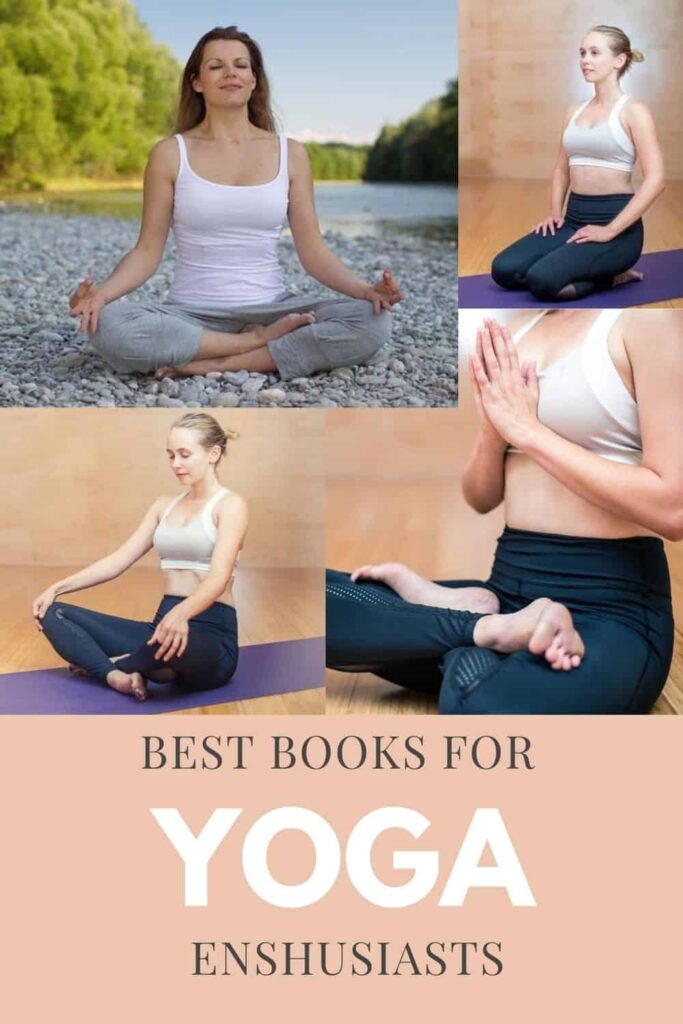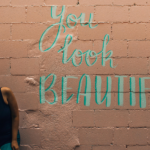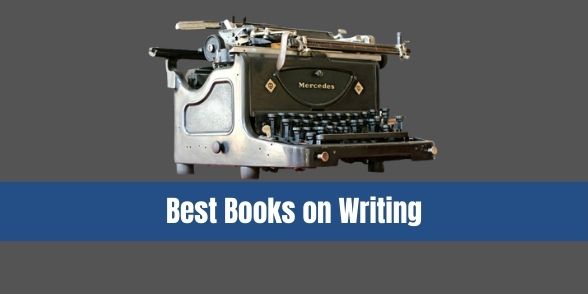You must have heard that nowadays people are turning more towards yoga rather than the gym. Why? To answer this question, we have this article on Best Books for Yoga Enthusiasts compiled for you.
Though the gym is apt for gaining muscle strengths and good physiques, yoga seemingly has more advantages. Yoga is widely practiced for health and relaxation. It includes a group of physical, spiritual and mental practices.
There are several benefits of doing yoga.
A person who is known for doing yoga frequently has better body balance and flexibility. It also helps in keeping various body pains at bay, manages stress, and maintains good heart health.
Some of you may not know that yoga originated in India and it was because of the transmission of knowledge and education that it spread throughout the world.
Now, many countries are promoting yoga as a means to a better lifestyle.

So today we have handpicked some books on yoga that can be used by yoga teachers as well as beginners who are curious to know more about it.
Read: All-time Best Children’s Book for Teaching Phonics
Read: Best Books on ESL for Teachers 2021
Being a yoga teacher or planning to become one, you must have every ounce of knowledge related to it. And, what other simple way to do that is read books related to it.
As a yoga enthusiast, you must be well aware of the importance and functioning of every posture, and how you can achieve well-being of the state of mind and as well body. I have been practicing yoga for a couple of years now. I have found these books very useful in learning yoga.
List of Best Books for Yoga Enthusiasts: Teachers, Students and Beginners
1. 2,100 Asanas: The Complete Yoga Poses
– by Daniel Lacerda and Mr. Yoga
“An Essential Book for Yoga Teachers.”

Check Here for Customer Reviews on Amazon
2,100 Asanas: The Complete Yoga Poses by Daniel Lacerda — This book was a New York Times bestseller. It is not only simply beautiful, comprehensive and educational but is also apt for beginners and as well as advanced yogis. If you had no idea that yoga had such many variations then a reading of this book will surely open your eyes. Daniel Lacerda begins the introduction of basic poses and then moves on to advanced and complex ones. Due to the number of yoga poses it talks about, it becomes a useful encyclopedia that mentions both the Sanskrit and English names of them.
2. The Heart of Yoga: Developing A Personal Practice
– by T. K. V Desikachar
“Read this book from page to page .. a valuable source of information on the principles and practice of yoga”

Click Here for Customer Reviews on Amazon
The Heart of Yoga: Developing A Personal Practice by T. K. V Desikachar — The author has taken inspiration from the teachings of the greatest yogi, Sri Tirumalai Krishnamacharya. Desikachar has based his method on the greatest yogi’s fundamental concept of viniyoga. He believes that practices should adapt according to an individual’s changing needs to ensure that maximum therapeutic value is achieved. The elements of yoga poses, meditation, conscious breathing and philosophy are also discussed by him. After reading this particular book, you can develop a specific practice by your age, health, lifestyle and occupation. We strongly recommend this book because unlike others it leads its readers to focus more on having the right understanding of yoga and how one needs to approach it for better personal growth.
3. Yoga Anatomy: Your Illustrated Guide to Postures, Movements, and Breathing Techniques
– by Leslie Kaminoff and Amy Matthews and Sharin Ellis
“An invaluable resource that will see you every movement in a new light.”

Click Here for Customer Reviews on Amazon
Yoga Anatomy: Your Illustrated Guide to Postures, Movements, and Breathing Techniques by Leslie Kaminoff and Amy Matthews and Sharin Ellis — A well-written book that Has great quality illustrations and diagrams for its readers. It can become a useful book for beginners, as it explains which muscles are used in each posture. This book can become your helping tool to achieve your goal. Both the authors, Leslie Kaminoff and Amy Matthews are recognized experts and teachers in breathing, bodywork and anatomy and thus have beautifully and effectively created this reference book for other yoga enthusiasts, instructors and practitioners.
4. Living Your Yoga: Finding The Spiritual in Everyday Life
– by Judith Hanson Lasater
“A book that can be read and re-read … offers practical ways to bring yoga into everyday life.”

Living Your Yoga: Finding The Spiritual in Everyday Life by Judith Hanson Lasater — The author expands the meaning of yoga. She believes that it is much more than the poses and breathing techniques but also includes daily life events. Judith Hanson Lasater firmly believes that one needs to deepen their relationship with their own selves, family, friends and the world they are living in. And based on this opinion, she has included chapters such as Relaxation, Empathy and worship. To sum up it is a wonderful book that helps you to bring up your yoga practice for the rest of your life.
5. Teaching Yoga: Exploring The Teacher-Student Relationship
– by Donna Farhi
“Essential Reading for Any Yoga Training Teacher.”

Teaching Yoga: Exploring The Teacher-Student Relationship by Donna Farhi — After training several yoga instructors and leading international yoga retreats for more than three decades, Donna Farhi wrote this book to share knowledge from her experiences. She talks about various topics like how to conduct business while teaching yoga, the need to create emotional and physical safety for the students and how to create a healthy student-teacher relationship. The book discusses good ethics and lays a base for how teachers need to teach.
6. Yoga Sequencing: Designing Transformative Yoga Classes
– by Mark Stephens
“A streamlined guide for all yoga teachers.”

Yoga Sequencing: Designing Transformative Yoga Classes by Mark Stephens — This book has a lot to offer to everyone. It introduces sixty-seven sequences of yoga poses that will be helpful to students, women, seniors and can also help to relieve depression and anxiety. It advises you on how to sequence yoga poses when there are a variety of students. The meditation techniques taught here give yoga its true transformative power. Mark has also provided a glossary of yoga-related words to ease understanding.
7. Yoga Adjustments: Philosophy, Principles and Techniques
– by Mark Stephens
“A very helpful resource for all teacher instructors, yoga teachers and yoga students.”

Yoga Adjustments: Philosophy, Principles and Techniques by Mark Stephens — An expert yoga instructor himself, the author, Mark Stephens introduces the art and practice of yoga through this book. He has divided the book into two parts. The first part titled ‘foundations’ talks about the methods and techniques of yoga. The second part is called ‘Application’ that demonstrates assistance to students in different postures. A thing not to forget is the special foreword by the yoga star Shiva Rea in the book.
8. The Key Poses of Hatha Yoga: Your Guide to Functional Anatomy in Yoga
– by Ray Long MD FRCSC
“Your constant companion in your journey from beginner to expert.”

The Key Poses of Hatha Yoga: Your Guide to Functional Anatomy in Yoga by Ray Long MD FRCSC — As the title of the book suggests it specifically focuses on the practice and benefits of hatha yoga. It helps in understanding the muscular anatomy of hatha yoga. There are some sections on the physiology of stretching, biomechanics of stretching and muscle awakening. The illustrations in the book are like an added advantage as then the information becomes easier for the readers to process.
9. Teaching Yoga: Essential Foundations and Techniques
– by Mark Stephens
“A great resource and guide for teachers and students, respectively.”

Teaching Yoga: Essential Foundations and Techniques by Mark Stephens — The author, Mark Stephens offers practical advice on how to set up a classroom and become a successful teacher. It can be used as a textbook in teacher training programs. The book describes the eleven styles of contemporary yoga, giving a brief history of each one of them. A great pick for those who wish to learn the names of poses in Sanskrit as well.
10. The Deeper Dimensions of Yoga: Theory and Practice
– by Georg Feuerstein
“A true chest of information, ideas and inspiration related to yoga”

The Deeper Dimensions of Yoga: Theory and Practice by Georg Feuerstein — The author is one of the few and a well-known scholar and teacher of yoga. He offers in-depth information on the 5000-year-old yoga tradition and discusses various topics like different styles of yoga, meditation, mantras, vegetarianism, and tantric yoga. Georg Feuerstein believes and shows that yoga is not only about some sets of physical exercises, but leads people on the path of self-transformation. A must-read for those who want to know everything about yoga.
FAQs
What is Yoga?
Yoga is a physical, mental, and spiritual discipline, originating in ancient India. It aims to release inner tensions and reach a state of permanent peace. The goal of yoga is to be able to concentrate completely (Dharana) and then merge with one’s ideal self (Samadhi).
Why do I need to be flexible?
If you’re embarking on a yoga journey, it’s useful to have an understanding of why flexibility is so important. The answer lies in yoga philosophy. In short, as your body lengthens, your breath deepens, and you gain control over energy flows within your body. This makes you more flexible and able to navigate through uncomfortable poses with ease and grace. Furthermore, studies have shown that flexibility can help prevent injuries and aid recovery when they do occur.
How should I breathe during my asanas?
There are many ways to breathe in yoga. Whatever you do, try to connect your breathing with your movements. If you’re inhaling during a movement, try to exhale during that same movement and vice versa. This helps with coordination, but also helps you become aware of how each part of your body feels when it’s performing particular actions.
What are the advantages of Yoga?
Advantages of practicing yoga include stress relief, boosted energy levels, increased flexibility and better sleep. Practicing regularly also helps strengthen your core muscles and improve posture. These benefits are likely to have an impact at work and home, too.
For example, regular exercise improves mental clarity, concentration and focus – which can make you more productive in meetings or lead to fewer mistakes at work. It’s hard to say which is a bigger advantage: fewer sick days or simply feeling better about yourself. Regardless of your reasons for practicing yoga, it’s safe to say that it’ll probably help you in some way every day – both physically and mentally.
What if I don’t want to perform difficult asanas?
If you are not a professional in yoga or you are suffering from some physical problem and want to avoid these asanas, then simply avoid performing these asanas. For example, people with back injuries shouldn’t perform Bakasana (crow pose). There is no need to practice what you can’t do well, and there is no use of doing poses that might cause more damage than they cure.
Is Yoga only done in a classroom environment?
Most of us learn yoga as children in classrooms with a teacher who lectures, and students who follow along. This is called sādhanā-yoga (the yoga of meditation). However, it is not uncommon to hear of individuals practicing yoga at home, without a teacher. They are simply meditating upon their own bodies. These are examples of nididhyāsana-yoga (the yoga of self-reflection), which relies entirely on oneself to initiate and guide their own process.
What are some common mistakes made by beginners?
Going to class and expecting to be a master at yoga. Beginners need to know it takes time for muscle memory to kick in, so patience is key. Being aware of how your body feels as you’re practicing is also important; if something doesn’t feel right, try changing your positioning or taking a break from yoga until your muscles adjust. And if you have chronic pain that may flare up during or after class, inform your instructor—it’s best they know what they are working with.
Can people with health issues or physical problems practice Yoga?
Yes. Contrary to popular belief, yoga can actually be a great form of exercise for individuals who have health issues or physical problems. For example, one of my students has asthma and another student had her knees replaced a couple of years ago. They both find that practicing yoga is much easier for them than walking or running because it helps them to move in ways that don’t stress their joints as much.
Do I need any equipment to start practicing Yoga at home?
Just like any other exercise program, you won’t need equipment to start practicing yoga. But a set of yoga props is not just for show. For example, if you suffer from a wrist injury or arthritis, or if your wrists hurt when you perform certain poses, it’s best to invest in a yoga mat. You can also buy blocks and straps to help you stretch safely.
Why do some poses look similar but have different names?
The poses have different names because they achieve different outcomes. For example, Urdhva Dhanurasana (Camel Pose) is commonly performed in yoga as a back strengthening pose, but it can also help to stretch your body backward and therefore helps with flexibility.
By contrast, Tadasana (Mountain Pose) is also a great posture for strength and flexibility building, as well as helping to align your body. With many yoga postures, there are other benefits that make them worth practicing beyond just one function.
Therefore, some names are shared between several similar looking exercises, whilst others may be more specific to their function or ability.
What type of yoga should I do?
This is a hard question to answer, as it really depends on your goals and how you want to apply yoga in your life.
There are numerous types of yoga practices that can be classified into three main categories: Hatha (basic poses for beginners), Vinyasa Flow (focuses on sun salutations and fluid movements between poses) and Ashtanga (more involved strength building poses).
You should try out some classes until you find one that works for you. Many gyms offer cheap or free introductory classes.
What if I can’t find any classes near me?
Fear not! There are a plethora of online resources that make learning yoga accessible to anyone, anywhere. Choose one that works for you. Many are free, but some require payment. To get started, check out Yoga Journal and Yoga Online TV. Whatever you choose, remember: focus on your breathing and be open to wherever your mind takes you. The important thing is to try—and have fun doing it! The rest will come with time and a lot of practice.
How often should I do yoga?
The frequency of your yoga practice depends on a variety of factors: your schedule, how flexible you are, and how far along you are in your yoga journey. If you’re just starting out, take it easy at first and only do as much as feels comfortable for you. As time goes by, and you get more accustomed to doing yoga, try gradually working up to practicing twice or even three times a week.
Should I pay for online yoga videos or get a personal trainer?
You do not need a personal trainer to learn yoga. In fact, you can save a lot of money by learning yoga online. However, if you are particularly out of shape or injured and would like extra guidance, you may want to pay for one-on-one yoga classes at your local studio or gym.
Can yoga be practiced at home?
Yes, there are many YouTube videos that can guide you. And, yes, with all due respect to your current teacher, a video by some yoga guru will be much more effective in guiding you. Whether you’re looking for a beginner or advanced level video, just google yoga home practice and choose any one of them; do not hesitate to include asanas like shavasana (corpse pose), sukhasana (easy pose) in your routine daily at home.
Should I start with Bikram/Hot Yoga?
No. Hot yoga is only for people who are already in shape and have gone through a regular yoga class. Bikram/Hot Yoga is intense and can harm your body if you do not get used to it slowly. Do normal yoga classes for a month or two, at least 3-4 times a week, then slowly go into hot yoga. You will thank me later!
Are there any risks associated with Yoga?
The primary risks associated with yoga are from falling or straining your muscles, which can result in minor sprains and injuries. In rare cases, yoga has led to greater injuries. If you have a medical condition that is made worse by stretching exercises or if you’re pregnant, check with your doctor before starting a yoga routine.
What kind of mat should I use?
The type of mat you use is an individual decision, depending upon your personal preferences. Whether you prefer a thicker mat, made from natural fibers like jute or coir, or a thinner and more lightweight one, may be determined by your level of experience and what type of flooring you prefer to work out on.
How much time should I dedicate to Yoga?
While there’s no right or wrong answer, it’s important to make sure that you are getting enough rest and eating a healthy diet, as well. When practicing yoga, always be conscious of your body to ensure you don’t overdo it—no one wants sore muscles for days! If you’re unsure about how much time is best for you, check with your doctor.
What do you need to start off with Yoga?
You need a positive and open mind, good will and enthusiasm. If you can manage to keep these three things intact, then you have what it takes to start off with yoga. You do not need any fancy equipment or additional cost. But be warned; if you’re looking for a quick fix or instant change of your physique, yoga is not for you.
Where can I find a good Yoga instructor?
It’s very important to find a good teacher. It could be more dangerous than helpful if you don’t know what you are doing. One way to do so is by asking other Yoga practitioners, friends, and family members who they use. Another way is to visit different studios, check their schedules and see who fits your schedule and needs. Remember that a good instructor should have certifications from accredited schools or associations, as well as experience in classes for both beginners and advanced students.
Do you have any tips to improve my practice?
The most important thing to do is listen to your body. You’ll know what works and what doesn’t by paying attention to how you feel.
For example, if you tend to have tight hamstrings, modify your posture so that you keep a wide stance and try a wide-legged variation of an exercise like triangle pose. The traditional triangle can be really tough for those with tight hamstrings.
If you struggle with balance, then focus more on holding poses for longer periods of time or using a prop like a chair or wall in more creative ways. It’s about finding different angles and variations—you might not like every single one, but listening to your body will tell you what is likely to work best for you as an individual.
Conclusion
So, this is my recommendation list about the best books on yoga. Whether you are a yoga teacher or a student or simply someone who wishes to change his lifestyle by learning yoga, the above books are there for your assistance.
No matter how busy you might be, you should be able to take out 15-20 minutes every day to do some sort of exercise. Either engage yourself in some kind of sport or get in the habit of doing yoga at home.
You can refer to Wikipedia to know more about Yoga.
If you are short of money to get yourself enrolled in a yoga class, then these same books will be at your rescue. The only thing you will need afterward is a bit of dedication towards it to get yourself on the move.
These recommendations should help you with your yoga. In case you wish your favorite books to be added to the Best Books for Yoga Enthusiasts: Teachers, Students and Beginners article, please leave a comment.
Related Articles:
- Master Self-Discipline: Transform Your Life in 2025 with These Essential Strategies!

- Ebook Design for Children’s Books: Capturing Young Minds Visually

- Expanding on the Value of Professional Fashion Design Services

- Get Custom African American Character Illustrations with Any Hairstyle

- Transform Your Look with Rasaline’s Expert Hairstyle and Fashion Advice

- Study Smarter, Not Harder: Your Ultimate Guide to Academic Success




![22 Best Books to Learn and Master Adobe Photoshop [2021] 23 22 Best Books to Learn and Master Adobe Photoshop [2021]](https://moneymintz.com/wp-content/uploads/2021/08/best-Books-to-Learn-Photoshop-768x427.jpg)


